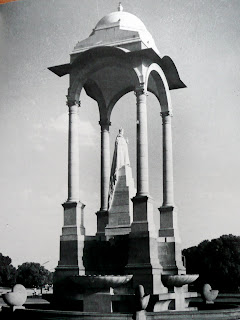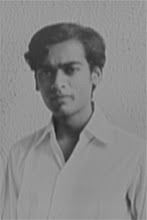
This fine statue once stood in Delhi, as this plaque below it recounts:

Now it stands in Queen's Park in Toronto, a sadly shabby space in the centre of this appearance-oblivious city. Paul Fonseca remarks in the Globe and Mail about the "rundown fountain surrounded by unplanted gardens," "the dilapidated benches" and "the neglected monument to a dead monarch." As for the last: how did it get there?
Delhi had many such statues, some of which had their ornamental qualities. The one shown below was at one end of Rajpat, or Kingsway, which has the fabulous Rashtrapati Bhawan, or President's Residence, at its other end.

This one has now been removed, and the pedestal stands empty. It is of George V, a somewhat thinner, but equally uncultured son of the man on a horse. The statue of Edward VII was also removed. These and many other statues were stored in kind of graveyard for imperial relics, on the grounds of the old Coronation Durbar, in Civil Lines near Delhi University.
Sometime in the sixties, Henry Jackman had the good idea that Toronto was in need of an equestrian statue. It had many good statues in front of the legislature building in Queen's Park, but all the men so honoured stood on their feet. Jackman contacted his friend, Roland Michener, then Canada's High Commissioner to India, to see if the Government of India would give Toronto its exiled Edward VII-on-horseback. GOI was only too willing to oblige.
The statue was cut into three pieces, shipped to Toronto, rewelded here, and erected in 1969. It looks good where it stands (though grass, as you can see, is a struggle in Toronto).

Canada and Toronto were unappreciative recipients. In her memoir of her father's time in India, Michener's daughter complains about how long it took to process the papers needed to export the statue. Nowhere in this memoir is there a word of gratitude for the gift. Nor is Toronto properly appreciative for who gave it its equestrian statue. Look closely at the plaque above: you'll see it says that the gift was "made possible" by the Government of India, along with "the former High Commissioner to India, His Excellency Roland Michener C.C, C.D., Governor General of Canada." Michener did indeed make the gift possible, and Jackman paid to transport and install it, but surely the Government or the people of India should be acknowledged as the donors (rather than as facilitators).
Jackman was right about equestrian statues: no city is complete without one. Soon others began to hear the call. A couple of blocks away, in St. Michael's College, there now stands this charming example of the genre:

Not quite as imposing as Edward Emperor of India perhaps, but at least this one doesn't look like the type who cadges money and mistresses from his friends.




No comments:
Post a Comment